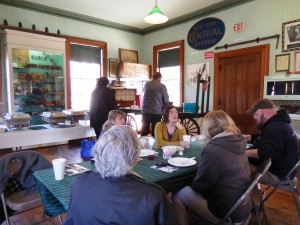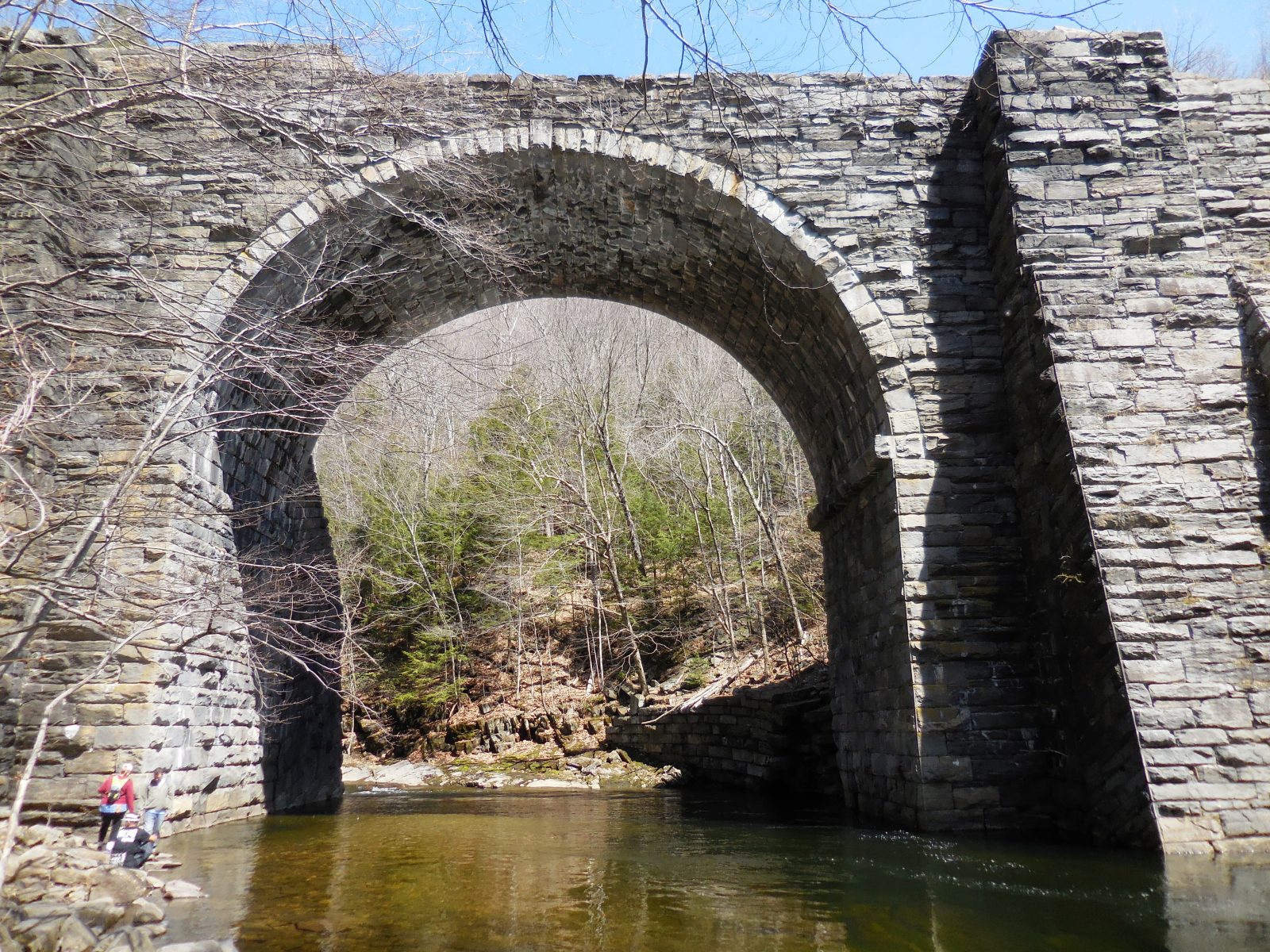CHESTER – The Jacob’s Ladder Business Association sponsored a breakfast at the Chester Railway Station and a guided hike on the Keystone Arch Bridges (K.A.B.) Trail on Saturday. David Pierce, president of the Friends of the Keystone Arches and the Chester Foundation spoke about the history of the bridges and the rail line on the five mile trek.
The Keystone Arch Bridges were built in the late 1830’s and completed in 1841 under the direction of West Point engineer Major George Washington Whistler, who was artist James McNeil Whistler’s father. The ten dry laid granite bridges, ranging to 70 feet in height, allowed the Western Railroad (later the Boston & Albany) to cross the meandering western branch of the Westfield River on its way to Albany, making it the longest and highest railroad in the world.
Whistler was also the first engineer to cut through a mountain pass for a railroad line, using picks, shovels and black powder. Part of the trail leads through a passage where manual cuts and drill marks are still seen in the stone. He completed the project in 2 ½ years, including the arches, which were built simultaneously by different crews mainly composed of newly-arrived Irish immigrants.

Members of the Jacob’s Ladder Business Assoc. have breakfast at the Chester Railway Museum before the hike to the Keystone Arch Bridges on Saturday. (Photo by Amy Porter)
The name Keystone refers to the building of the bridges based on Roman arches. The keystone is the center stone of the arch, against which the ring stones forming the rest of the arch are balanced. The strength of the design, which is considered one of three major advances in the science of spanning large spaces, according to Pierce, is evident by the durability of the bridges.
Two of the bridges are still in use by the railroad, now owned by CSX Transportation, carrying trains 30 times heavier than they were designed for. In 1830, a steam locomotive weighed about 12,000 lbs. The average locomotive of today weighs 350,000 lbs, Pierce said.
Three of the other original bridges that were bypassed by the railroad line relocation in 1912 have stood for 104 years with no maintenance whatsoever, and one is halfway standing, revealing the interior architecture.
Pierce launched a drive in February to make the Keystone Arch bridges a National Historic Landmark. His goal is preservation of the abandoned Keystone Arches. A $1 million grant that had been pledged by Mass Highway for restoration of the 65 ft. and 70 ft. abandoned arches was withdrawn in 2005 mainly due to the inability to negotiate access to CSX land after year-long negotiations.
Meanwhile, volunteers are doing what they can to help with the restoration. Most of the abandoned bridges are missing the one-ton free-standing granite capstones that edged the top of the bridges, and were pushed into the river below by vandals, according to Pierce.
Pierce said volunteer divers have located many of the stones, and an effort is underway to haul them to the top of the two bridges. Replacement stones of Chester Blue granite that were cut with grant funding are also stockpiled at the Chester Granite Co., awaiting delivery to the site.
The K.A.B. trail itself was built entirely on state Division of Fisheries & Wildlife (DFW) land by volunteers from AmeriCorps and the Gateway Regional School District, among a number of other area organizations. Students from Gateway’s welding program also made informational kiosks along the trail that point out the standing bridges. It was completed in 2004 with the addition of a 65 ft. footbridge that crosses a small gorge.
The trail also follows the path of the magnificent west branch of the Westfield River, the first river in Massachusetts to receive a Wild and Scenic designation. Some of the best views of the arches require side trips off the main trail down to the river, and a guided tour is helpful.
Pierce has been involved in the promotion and preservation work of the bridges and the Chester Railway Station for the past 30 years.
“We are humbled by the amount of time, effort, and finances that have gone into preserving the amazing history of our historic landmarks in Chester. The Jacob’s Ladder Business Assoc. is proud to be able to be a small part of introducing this to a wider audience,” said JLBA President Michele Kenney, who thanked Dave Pierce and the Chester Foundation for the hike.
The Chester Railway Museum will also host the Dixieland Stomp for a free concert on Thursday, April 28 from 7 to 8:30 p.m., sponsored by the Chester Cultural Council.
Pierce and the Chester Foundation will also be running the 25th annual Chester on Track on Saturday, May 21. Models of the Keystone Arch bridges are on display in the 1840 Chester Railway Museum, where N scale model trains will also be setup for the event. Visitors may also enter a number of 1920’s-era freight cars, including a wooden caboose, and a ‘children’s boxcar’ that will be open to public.
Also at the free day-long Chester on Track will be a parade, Civil War, CCC Camp, and Blacksmith demonstrations, and a classic car and tractor show.
For more information on the Keystone Arch bridges, go to www.keystonearches.com, www.ChesterRailwayStation.net, or the Chester Railway Station on Facebook.


